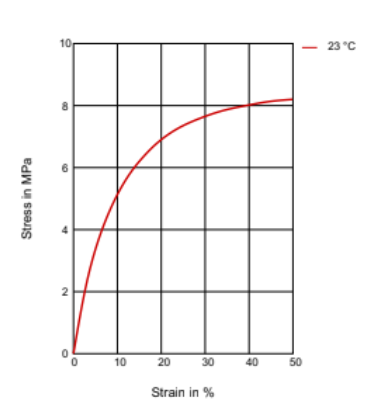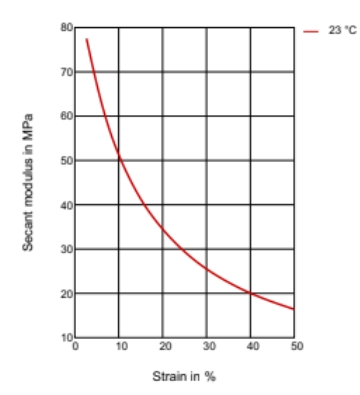Enhanced TDS
Identification & Functionality
- Additives Included
- Blend
- Yes
- Chemical Family
- Country of Origin
- Polymer Name
- Product Code
- MITM15140
- Single Ingredient
- No
- Technologies
- Product Families
Features & Benefits
- Labeling Claims
- Materials Features
Applications & Uses
- Plastics & Elastomers End Uses
- Plastics & Elastomers Processing Methods
- Markets
- Applications
- Processing Information
Injection Molding, Film Extrusion, Profile Extrusion, Other Extrusion, Transfer Molding, Casting, Thermoforming.
Properties
Technical Details & Test Data
- Technical Data
Stess-Strain Diagram:

Secant Modulus-Strain Diagram:

Processing Conditions (Injection molding):
- Typical melt temperature (Min / Recommended / Max): 200°C / 240°C / 270°C.
- Typical mold temperature: 10 - 30°C.
- Drying time and temperature (only necessary for bags opened for more than two hours): 4-8 hours at 60-70°C.
Processing Conditions (Extrusion):
- Typical melt temperature (Min / Recommended / Max): 210°C / 220°C / 230°C.
- Drying time and temperature (only necessary for bags opened for more than two hours): 4-8 hours at 60-70°C.
Packaging & Availability
- Packaging Type
Principal Information
- Group Principal Number
- S000003
- Principal
Other
- Color (SDS)
- Colorless to slightly yellow
- Item Number
- Odor (SDS)
- Odorless
- Other Hazards
- Processing may release vapors and/or fumes which cause eye, skin and respiratory tract irritation, Prolonged or repeated exposure may cause: headache, drowsiness, nausea, weakness, (severity of effects depends on extent of exposure).
- Temperature Control
- Yes
- USA/DOT UN Number
- Not Applicable
- Material Composition
Value Units Test Method / Conditions Carbon Content 45.0 % % ASTM D6866 - Mechanical Properties
Value Units Test Method / Conditions Hardness 39.0 Shore D Shore D Hardness 39.0 Shore A Shore A ISO 868 Strain at Break min. 300.0 % % ISO 527-1 at break thermoplastic elastomer, dry Strain at Break min. 50.0 % % ISO 527-2 at break, condensed Stress 8.2 MPa MPa ISO 527-2 at 50% strain, condensed Stress at Break 45.0 MPa MPa ISO 527-1 at break thermoplastic elastomer, dry Tensile Modulus 75.0 MPa MPa ISO 527-2 condensed - Physical Properties
Value Units Test Method / Conditions Density 1030.0 kg/m³ kg/m³ ISO 1183 condensed Density 1030.0 kg/m³ kg/m³ ISO 1183 dry basis Humidity Absorption 0.5 % % ISO 62 dry basis Melting Point 148.0 °C °C ISO 11357-1 at 10°C/min Mold Shrinkage 0.7 % % ISO 2577 normal, dry Mold Shrinkage 0.6 % % ISO 2577 parallel, dry Mold Shrinkage 0.7 % % ISO 294-4 normal, dry Mold Shrinkage 0.6 % % ISO 294-4 parallel, dry Storage Temperature max. 140.0 °F °F Water Absorption 1.3 % % ISO 62 dry basis - SDS Physical and Chemical Properties
Value Units Test Method / Conditions Decomposition Temperature (SDS) 572.0-662.0 °F °F Lower Explosion Limit (SDS) 45.0 % % at 85⁰C Melting Point (SDS) 383.0 °F °F - Shelf Life & Stability
Value Units Test Method / Conditions Shelf Life 2.0 yr yr
